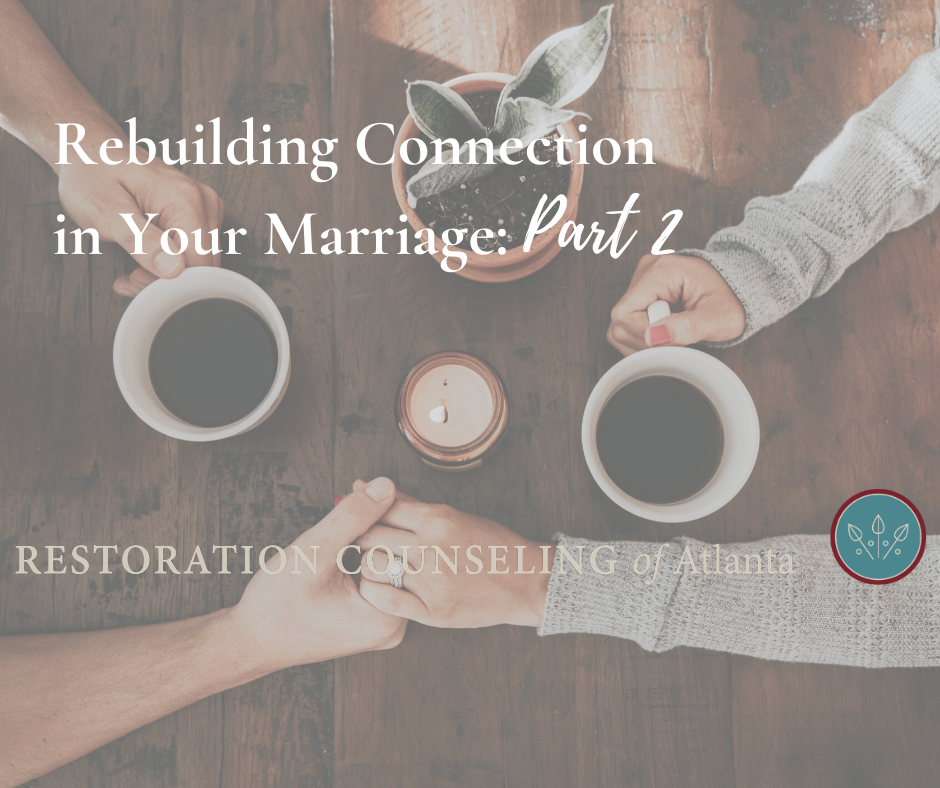In last month’s article, Rebuilding Connection in Your Marriage: Part 1, I laid the foundation for empathy as the single most important factor in healthy relationships. This month, I want to give you advice in three areas that will build upon that foundation.
Focus Areas for Rebuilding Connection
1. Responding to Bids for Affection
The Gottman Institute is a research group that focuses on relationship satisfaction and longevity. In one of their studies, they observed newlywed couples as they bid for intimacy. They also observed their partner’s willingness to turn towards or away from their bid. To put it simply, when one partner makes a bid, extending an opportunity for connection, the other has the option of engaging with them or rejecting them. The Institute then followed up with the couples six years later. The couples that were still married had averaged turning towards their partner’s bids 86% of the time. The divorced couples averaged turning towards their partner only 33% of the time. That is a powerful testimony to the benefit of turning towards your spouse as he or she makes a bid for intimacy.
When your spouse makes a bid for affection (offering to help in the kitchen, reaching out to cuddle on the couch, inviting you to join them in an activity they enjoy or seeking to connect sexually), understand that they are risking some level of vulnerability. Each bid asks the question, “Do you want to be with me?” Each rejection, big and small, should be done intentionally and with kindness. If you don’t feel like connecting or engaging with your spouse, try to offer a counter bid. Suppose your spouse invites you to join them in their hobby, but you don’t want to. Instead of simply saying no, turn towards them, acknowledge their attempt at connection, and offer something else instead. When your spouse initiates sexual intimacy and you aren’t in the mood, you have several options. You could offer to cuddle instead, please them physically, or propose another time when sex would be an option. The important thing is the reassurance that affection still abounds.
2. Creating Positive Interactions
It is important to create positive interactions with your spouse. According to another study from The Gottman Institute, there is a “magic ratio” of positive and negative interactions. Healthy couples maintain an average of five positive interactions for every one negative. These can be diverse, drawing from any of the five love languages: quality time, physical touch, words of affirmation, gifts, or service. I challenge you to go through your day and try to keep track of your interactions and figure out your current ratio. If you are low, try to sprinkle in one or two extra positive interactions with your spouse throughout the day. These can be as simple as an expression of gratitude, a compliment, a good hug, or expressing interest in their day.
3. Touching
Finally, I want to encourage you and your spouse to touch each other. There may have been a time when you and your spouse could barely keep your hands off each other. This kind of bliss communicates desire, connection, and safety. But as the years have passed and responsibilities grow and change, these kinds of interactions are difficult, if not impossible, to maintain. However, as you seek to improve your marriage and rebuild intimacy, the secret may be found in physical touch. The correlation of physical touch and relationship satisfaction is extremely strong. A physical touch from a loved one has been shown to reduce anxiety, promote relaxation, and even acts as an analgesic.
Get Started
If you are looking for ways to rebuild connection and intimacy in your relationship, these are great places to start. Turn towards your partner when they make bids for connection. Maintain a healthy ratio of positive to negative interactions. And whenever possible, lovingly touch your spouse.
References
Gulledge, A., Gulledge, M., & Stahmannn, R. (2003) Romantic Physical Affection Types and Relationship Satisfaction, American Journal of Family Therapy, 31:4, 233-242
Luciano L’abate PhD (2001) Hugging, Holding, Huddling and Cuddling (3HC), Journal of Clinical Activities, Assignments & Handouts in Psychotherapy Practice, 1:1, 5-18
Triscoli, C., Croy, I., Olausson, H., & Sailer, U. (2017) Touch between romantic partners: Being stroked is more pleasant than stroking and decelerates heart rate. Physiology & Behavior, 177, 169-175.
www.gottman.com/blog/turn-toward-instead-of-away/
www.gottman.com/blog/the-magic-relationship-ratio-according-science/

Written by: Kyle Sussenbach, LAMFT
Roswell location
kyle@restorationcounselingatl.com, ext. 117
Kyle is trained to work with individuals, couples, and families experiencing a wide range of issues including depression, anxiety, addictions, anger, suicidality, and relational distress. He also pursued further training related to sexual issues including shame, dysfunction, addiction, paraphilia, and trauma.
He is certified in PREPARE/ENRICH and is a Level 2 Gottman Method Couples Therapist. His primary focus is working with couples through relational and sexual difficulties. He is passionate about marriage and its purpose in sanctifying the couple and illustrating the relationship between Christ and the Church.

